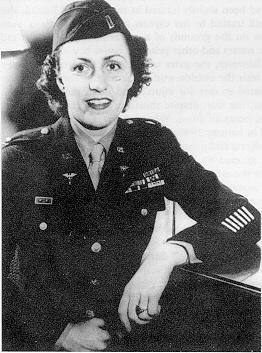1st. Lt. Rita G. (Palmer) James
By Michael Bisceglia
Hampton Union, Friday, October 26, 2007
[The following article is courtesy of the Hampton Union and Seacoast Online.]

Feb. 23, 1918 – Feb. 14, 2002
[Photo courtesy Ansell W. Palmer]
On Aug. 7, 1782, George Washington, commander-in-chief of the Continental Army, initiated the Badge of Military Merit. He wanted to recognize those soldiers who gave extraordinary service in the Revolutionary War.
Three men received the award. The use of the award fell into disuse until after World War I.
On Jan. 7, 1931, Army Chief of Staff, Gen. Douglas MacArthur had the award redesigned and renamed. It was named the Purple Heart.
In 1942, the award was reinstituted to recognize only those individuals who had been wounded in action. Until World War II, no woman had been awarded the medal.
Rita Palmer was born on Feb. 23, 1918 in Exeter Hospital. She was one of 21 students to graduate from Hampton Academy in 1936. She was a direct descendant of William Palmer, one of Hampton’s first settlers.
Rita and Ansell, her brother, were fun-loving youth and good students. It wasn’t uncommon to see the pair cruising the streets of Hampton in Ansell’s model T-Ford racer, “the Comet.” Rita, the first editor of Hampton Academy’s ‘Script’ was described by her classmates as “a lot of fun” and “very caring.”
One evening, she and her high school chum, Margaret Noyes Lovett went to the movies in Portsmouth. The film featured a nurse. During the movie, Rita nudged Margaret to say, “That’s what I want to do.”
True to her word, Rita graduated from Deaconess Hospital Nurses Training, Boston, in 1939. In 1940, she joined the U.S. Army Nurses Corps and was assigned to Clark Field Hospital in the Philippines. When war broke out, she served in field hospitals in Bataan and Corregidor until the American surrender there. At that time, she was wounded and taken prisoner. Rita was held for three years until the American liberation in 1945. She received the Oak Leaf Cluster and was the first woman to receive the Purple Heart.
Despite her injuries, Palmer claimed she was treated well by her captors, and continued to care for the sick and injured prisoners. At the time of her rescue, she was weak from hunger and dressed in shorts and a pajama top.
Aside from her shrapnel wounds, Rita suffered hepatitis and beriberi because of the poor quality of her rations.
Lt. Palmer arrived in San Francisco on Feb. 23, her 27th birthday. She was given a small party and claimed that she had gained a pound each day since she was liberated. At that time, she had gained 20 pounds. On her birthday, she weighed 105 pounds.
Rita arrived home on March 3, 1945. Church bells began ringing throughout the town one hour before her arrival to summon the community. Well-wishers met her at Toppan’s Corner and marched with the car carrying Rita and her parents to Hampton Square. She was one of 68 nurses to be liberated from a Japanese prison camp in Manila.
Rita married Richard James of Minneapolis, also a Purple Heart recipient. They had two sons and two daughters. Rita died on Valentine’s Day, Feb. 14, 2002, in Hopkins, Minn. She was 83.
In her later years, she was asked about the war and her experiences. She said the memories didn’t come back easily, and that was just as well. In a letter to her brother, she once wrote, “I have not successfully come to terms with everything that happened in those years. I learned some valuable lessons, a great deal about human nature under extreme conditions and the recognition that little is gained and nothing is resolved by war.”
In 1988, Rita’s story was turned into a television movie, “Women of Valor.” Ansell Palmer resides in his hometown of Hampton.
A special thanks to John Holman, Hampton History Volunteer, Lane Memorial Library and Peter Randall, Hampton, A Century of Town & Beach,1898-1998, of Hampton.
[Mike Bisceglia Jr. is a freelance writer who lives in Hampton.]